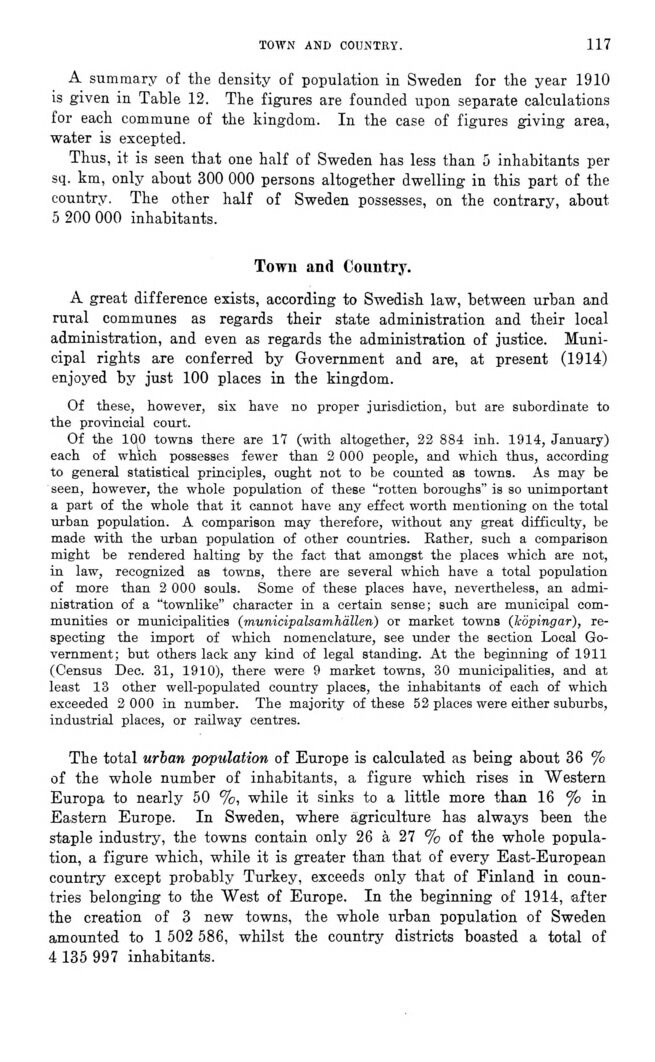
Full resolution (JPEG) - On this page / på denna sida - II. The Swedish People - 2. Demography. By [G. Sundbärg] E. Arosenius

<< prev. page << föreg. sida << >> nästa sida >> next page >>
Below is the raw OCR text
from the above scanned image.
Do you see an error? Proofread the page now!
Här nedan syns maskintolkade texten från faksimilbilden ovan.
Ser du något fel? Korrekturläs sidan nu!
This page has never been proofread. / Denna sida har aldrig korrekturlästs.
TOWN AND COUNTRY.
117
A summary of the density of population in Sweden for the year 1910
is given in Table 12. The figures are founded upon separate calculations
for each commune of the kingdom. In the case of figures giving area,
water is excepted.
Thus, it is seen thai one half of Sweden has less than 5 inhabitants per
sq. km, only about 300 000 persons altogether dwelling in this part of the
country. The other half of Sweden possesses, on the contrary, about
5 200 000 inhabitants.
Town and Country.
A great difference exists, according to Swedish law, between urban and
rural communes as regards their state administration and their local
administration, and even as regards the administration of justice.
Municipal rights are conferred by Government and are, at present (1914)
enjoyed by just 100 places in the kingdom.
Of these, however, six have no proper jurisdiction, but are subordinate to
the provincial court.
Of the 100 towns there are 17 (with altogether, 22 884 inh. 1914, January)
each of w hich possesses fewer than 2 000 people, and which thus, according
to general statistical principles, ought not to be counted as towns. As may be
seen, however, the whole population of these "rotten boroughs" is so unimportant
a part of the whole that it cannot have any effect worth mentioning on the total
urban population. A comparison may therefore, without any great difficulty, be
made with the urban population of other countries. Rather, such a comparison
might be rendered halting by the fact that amongst the places which are not,
in law, recognized as towns, there are several which have a total population
of more than 2 000 souls. Some of these places have, nevertheless, an
administration of a "townlike" character in a certain sense; such are municipal
communities or municipalities (municipalsamhällen) or market towns (köpingar),
respecting the import of which nomenclature, see under the section Local
Government; but others lack any kind of legal standing. At the beginning of 1911
(Census Dec. 31, 1910), there were 9 market towns, 30 municipalities, and at
least 13 other well-populated country places, the inhabitants of each of which
exceeded 2 000 in number. The majority of these 52 places were either suburbs,
industrial places, or railway centres.
The total urban population of Europe is calculated as being about 36 %
of the whole number of inhabitants, a figure which rises in Western
Europa to nearly 50 %, while it sinks to a little more than 16 % in
Eastern Europe. In Sweden, where agriculture has always been the
staple industry, the towns contain only 26 à 27 % of the whole
population, a figure which, while it is greater than that of every East-European
country except probably Turkey, exceeds only that of Finland in
countries belonging to the West of Europe. In the beginning of 1914, after
the creation of 3 new towns, the whole urban population of Sweden
amounted to 1 502 586, whilst the country districts boasted a total of
4 135 997 inhabitants.
<< prev. page << föreg. sida << >> nästa sida >> next page >>